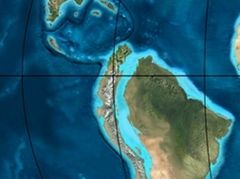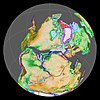Guaduas Formation
 From Wikipedia the free encyclopedia
From Wikipedia the free encyclopedia
| Guaduas Formation | |
|---|---|
| Stratigraphic range: Maastrichtian-Paleocene ~ | |
 Coal from the Guaduas Formation, Páramo de Ocetá | |
| Type | Geological formation |
| Underlies | Cacho Formation |
| Overlies | Guadalupe Gp. Arenisca Labor-Tierna Fm. |
| Thickness | up to 1,090 metres (3,580 ft) |
| Lithology | |
| Primary | Shale |
| Other | Sandstone, coal |
| Location | |
| Coordinates | 5°05′N 74°36′W / 5.083°N 74.600°W |
| Region | Middle Magdalena Basin Magdalena River Valley Altiplano Cundiboyacense Eastern Ranges, Andes |
| Country | |
| Type section | |
| Named for | Guaduas |
| Named by | Hubach |
| Location | Guaduas |
| Year defined | 1931 |
| Coordinates | 5°05′N 74°36′W / 5.083°N 74.600°W |
| Approximate paleocoordinates | 0°36′N 52°30′W / 0.6°N 52.5°W |
| Region | Cundinamarca, Boyacá |
| Country | |
 Paleogeography of Northern South America 65 Ma, by Ron Blakey | |
The Guaduas Formation (Spanish: Formación Guaduas, K2P1G, K2E1G, KPgg, KTg, TKg, Ktg) is a geological formation of the Middle Magdalena Basin and the Altiplano Cundiboyacense, Eastern Ranges of the Colombian Andes. The predominantly shale with coalbed formation dates to the Late Cretaceous and Paleogene periods; Maastrichtian-Paleocene epochs, and has a maximum thickness of 1,090 metres (3,580 ft). Fossils of Coussapoa camargoi, Ficus andrewsi, Berhamniphyllum sp. and Archaeopaliurus boyacensis have been found in coalbeds in Zipaquirá and Tasco, Boyacá.
Etymology
[edit]The formation was first described by Hettner in 1894 and named in 1931 by Hubach after Guaduas, Cundinamarca, former northern territory of the Panche.[1]
Description
[edit]Lithologies
[edit]The Guaduas Formation consists mainly of shales with intercalated sandstone beds. The formation contains coalbeds that are widely explored in the area.[2] Fossil remains of Coussapoa camargoi, Ficus andrewsi, Berhamniphyllum sp. and Archaeopaliurus boyacensis have been found in coalbeds in Zipaquirá and Tasco, Boyacá.[3][4][5]
Stratigraphy and depositional environment
[edit]The Guaduas Formation unconformably[6] overlies the Arenisca Labor-Tierna Formation of the Guadalupe Group and is overlain by the Cacho Formation. The age has been estimated to be Upper Maastrichtian-Lower Paleocene, spanning the K-T boundary.[7] The Guaduas Formation is thicker in Cundinamarca than in Boyacá. This has been explained by a decrease in subsidence and a higher amount of erosion in the northern area of original deposition.[8] The lateral thickness variations are thought to be the result of the movement of the Soapaga Fault.[9] The formation has been deposited in a coastal plain setting.[4]
Outcrops
[edit]The Guaduas Formation is apart from its type locality, found in the Eastern Hills of Bogotá, the Ocetá Páramo and many other locations in the Eastern Ranges, such as Granada,[10] the Dintel Synclinal north of Facatativá,[11] the Suesca Synclinal,[12] east of Junín,[13] and surrounding Lake Tota.[14] The northeast-southwest Canocas Fault crosscuts the Guaduas Formation near San Cayetano.[15] The synclinals of the Río Frío, Neusa, Zipaquirá, Checua-Lenguazaque, Sesquilé, Sisga, Subachoque, Teusacá and Usme and Soacha are composed of the Guaduas Formation.[2] The Suba Hills are entirely composed of the Guaduas Formation.[16] The formation also has outcrops in the Sumapaz Páramo.[17]
Regional correlations
[edit]
- Legend
- group
- important formation
- fossiliferous formation
- minor formation
- (age in Ma)
- proximal Llanos (Medina)[note 1]
- distal Llanos (Saltarin 1A well)[note 2]
Gallery
[edit]- Coal mining in the Guaduas Formation
Ocetá Páramo
See also
[edit]Notes and references
[edit]Notes
[edit]References
[edit]- ^ Montoya & Reyes, 2005, p.51
- ^ a b Montoya & Reyes, 2005, p.52
- ^ Coussapoa camargoi, Ficus andrewsi at fossilworks.org
- ^ a b Berhamniphyllum sp. & Archaeopaliurus boyacensis Archived 2018-09-10 at the Wayback Machine at fossilworks.org
- ^ 'Archaeopaliurus boyacensis' in the Paleobiology Database
- ^ Villamil, 2012, p.208
- ^ Montoya & Reyes, 2005, p.54
- ^ Mariño & Amaya, 2016, p.B9
- ^ Amaya et al., 2010
- ^ Plancha 246, 1998
- ^ Plancha 227, 1998
- ^ Plancha 190, 2009
- ^ Plancha 191, 1998
- ^ Plancha 192, 1998
- ^ Planchas 171 & 191
- ^ Geological Map Bogotá, 1997
- ^ (in Spanish) Geología y geomorfología - Salida de Campo: Región Llanos Orientales
- ^ a b c d e f García González et al., 2009, p.27
- ^ a b c d e f García González et al., 2009, p.50
- ^ a b García González et al., 2009, p.85
- ^ a b c d e f g h i j Barrero et al., 2007, p.60
- ^ a b c d e f g h Barrero et al., 2007, p.58
- ^ Plancha 111, 2001, p.29
- ^ a b Plancha 177, 2015, p.39
- ^ a b Plancha 111, 2001, p.26
- ^ Plancha 111, 2001, p.24
- ^ Plancha 111, 2001, p.23
- ^ a b Pulido & Gómez, 2001, p.32
- ^ Pulido & Gómez, 2001, p.30
- ^ a b Pulido & Gómez, 2001, pp.21-26
- ^ Pulido & Gómez, 2001, p.28
- ^ Correa Martínez et al., 2019, p.49
- ^ Plancha 303, 2002, p.27
- ^ Terraza et al., 2008, p.22
- ^ Plancha 229, 2015, pp.46-55
- ^ Plancha 303, 2002, p.26
- ^ Moreno Sánchez et al., 2009, p.53
- ^ Mantilla Figueroa et al., 2015, p.43
- ^ Manosalva Sánchez et al., 2017, p.84
- ^ a b Plancha 303, 2002, p.24
- ^ a b Mantilla Figueroa et al., 2015, p.42
- ^ Arango Mejía et al., 2012, p.25
- ^ Plancha 350, 2011, p.49
- ^ Pulido & Gómez, 2001, pp.17-21
- ^ Plancha 111, 2001, p.13
- ^ Plancha 303, 2002, p.23
- ^ Plancha 348, 2015, p.38
- ^ Planchas 367-414, 2003, p.35
- ^ Toro Toro et al., 2014, p.22
- ^ Plancha 303, 2002, p.21
- ^ a b c d Bonilla et al., 2016, p.19
- ^ Gómez Tapias et al., 2015, p.209
- ^ a b Bonilla et al., 2016, p.22
- ^ a b Duarte et al., 2019
- ^ García González et al., 2009
- ^ Pulido & Gómez, 2001
- ^ García González et al., 2009, p.60
Bibliography
[edit]- Amaya, Erika; Mariño, Jorge; Jaramillo, Carlos (2010), "Litofacies y ambientes de acumulación de la Formación Guaduas en al parte central de la Cordillera Oriental - implicaciones paleogeográficas", Boletín de Geología, Universidad Industrial de Santander, 32 (1): _, retrieved 2017-03-16
- García González, Mario; Mier Umaña, Ricardo; Cruz Guevara, Luis Enrique; Vásquez, Mauricio (2009), Informe Ejecutivo - evaluación del potencial hidrocarburífero de las cuencas colombianas, Universidad Industrial de Santander, pp. 1–219
- Mariño M., Jorge E; Amaya, Erika (2016), "Lithofacies cyclicity determination in the Guaduas Formation using Markov chains", Earth Sciences Research Journal, Universidad Nacional de Colombia, 20: B1-9
- Montoya Arenas, Diana María; Reyes Torres, Germán Alfonso (2005), Geología de la Sabana de Bogotá, INGEOMINAS, pp. 1–104
- Villamil, Tomas (2012), Chronology Relative Sea Level History and a New Sequence Stratigraphic Model for Basinal Cretaceous Facies of Colombia, Society for Sedimentary Geology (SEPM), pp. 161–216
Maps
[edit]- Vargas, Rodrigo; Arias, Alfonso; Jaramillo, Luis; Tellez, Noel (1984), Plancha 136 - Málaga - 1:100,000, INGEOMINAS, p. 1, retrieved 2017-06-06
- Renzoni, Giancarlo; Rosas, Humberto (2009), Plancha 171 - Duitama - 1:100,000, INGEOMINAS, p. 1, retrieved 2017-06-06
- Ulloa, Carlos E.; Guerra, Álvaro; Escovar, Ricardo (1998), Plancha 172 - Paz de Río - 1:100,000, INGEOMINAS, p. 1, retrieved 2017-06-06
- Fuquen M., Jaime A; Osorno M, José F. (2009), Plancha 190 - Chiquinquirá - 1:100,000, INGEOMINAS, p. 1, retrieved 2017-06-06
- Renzoni, Giancarlo; Rosas, Humberto; Etayo Serna, Fernando (1998), Plancha 191 - Tunja - 1:100,000, INGEOMINAS, p. 1, retrieved 2017-06-06
- Ulloa, Carlos E.; Rodríguez, Erasmo; Escovar, Ricardo (1998), Plancha 192 - Laguna de Tota - 1:100,000, INGEOMINAS, p. 1, retrieved 2017-06-06
- Ulloa, Carlos; Acosta, Jorge (1998), Plancha 208 - Villeta - 1:100,000, INGEOMINAS, p. 1, retrieved 2017-06-06
- Montoya, Diana María; Reyes, Germán (2009), Plancha 209 - Zipaquirá - 1:100,000, INGEOMINAS, p. 1, retrieved 2017-06-06
- Terraza, Roberto; Moreno, Giovanni; Buitrago, José A.; Pérez, Adrián; Montoya, Diana María (2010), Plancha 210 - Guateque - 1:100,000, INGEOMINAS, p. 1, retrieved 2017-06-06
- Ulloa, Carlos E; Rodríguez, Erasmo; Acosta, Jorge E. (1998), Plancha 227 - La Mesa - 1:100,000, INGEOMINAS, p. 1, retrieved 2017-06-06
- Buitrago, José Alberto; Terraza M., Roberto; Etayo, Fernando (1998), Plancha 228 - Santafé de Bogotá Noreste - 1:100,000, INGEOMINAS, p. 1, retrieved 2017-06-06
- Acosta, Jorge E.; Ulloa, Carlos E. (1998), Plancha 246 - Fusagasugá - 1:100,000, INGEOMINAS, p. 1, retrieved 2017-06-06
- Nuñez, Alberto; Mosquera, Dario; Vesga, Carlos J. (2009), Plancha 263 - Ortega - 1:100,000, INGEOMINAS, p. 1, retrieved 2017-06-06
- Acosta, Jorge; Calcedo, Juan Carlos; Ulloa, Carlos (1999), Plancha 265 - Icononzo - 1:100,000, INGEOMINAS, p. 1, retrieved 2017-06-06
- Acosta, Jorge; Caro, Pablo; Fuquen, Jaime; Osorno, José (2002), Plancha 303 - Colombia - 1:100,000, INGEOMINAS, p. 1
- Velandia, Francisco; Cepeda, Héctor (2005), Planchas 171 & 191 - Geología sector del sur del municipio de Paipa (Boyacá) - 1:25,000, INGEOMINAS
- Various, Authors (1997), Mapa geológico de Santa Fe de Bogotá – Geological Map Bogotá – 1:50,000 (PDF), INGEOMINAS, p. 1, retrieved 2017-03-16 Archived 2017-11-22 at the Wayback Machine
External links
[edit]- Gómez, J.; Montes, N.E.; Nivia, Á.; Diederix, H. (2015), Plancha 5-09 del Atlas Geológico de Colombia 2015 – escala 1:500,000, Servicio Geológico Colombiano, p. 1, retrieved 2017-03-16


























